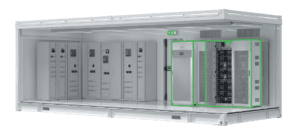Digitization of the classroom has been a key focus for school districts in recent years, but the COVID-19 pandemic forced school districts to switch overnight to fully remote learning, turning a nice-to-have into a must-have and putting an enormous strain on the hodge-podge of network and server rooms that have evolved over the years at many schools. Districts are now challenged with providing an educational IT infrastructure that can support the digital classroom without disruption as students return to in-person learning.
To address these challenges, school districts are turning to prefabricated modular data centers. They are becoming an attractive and widespread option for districts looking to consolidate their distributed compute resources into one efficient, secure, resilient, and flexible facility designed to provide uninterrupted services, even if school buildings close down or lose power.

Benefits of Modular Data Centers
Modular data centers satisfy the unique and changing requirements of school districts in a variety of ways:
TIME: School districts don’t want disruptive and noisy construction going on during the school year. More importantly in 2020-21, school districts had to go online and/or ramp-up digital capabilities quickly to continue to deliver high-quality virtual learning during the pandemic. A modular data center addresses these issues because the actual construction takes place in the factory and deployment times are 50% faster than traditional builds. With an all-in-one modular data center, the pre-build data center is installed along with everything that goes with it: power, cooling, fire suppression system, emergency generator, UPS, and server racks – ready for use.
SPACE: Some schools were built before the advent of computers and even newer school buildings might not have the physical space required to meet the growing digital needs of today’s students. School districts looking to modernize, expand, and disaster-proof their digital infrastructure are faced with the choice of either finding space within existing buildings or taking on a new construction project.
A modular approach solves that problem. The data center can be built outdoors adjacent to the school. There’s no disruption to education during the process and all a school district needs to do once the modular data center has been installed is to connect to electricity and data.
FUTURE GROWTH: The modular approach enables school districts to design a data center with enough compute power and storage to handle current workloads and to have extra capacity for growth. One of the advantages of the modular approach is that if digital needs dramatically increase in the future, school districts can easily and quickly add another module.
EXPERTISE: The data center vendor typically has the experience and the know-how to handle the entire process from the design and planning stages, to the construction phase, to remote monitoring and management as well as predictive maintenance. This enables school IT staff to focus on day-to-day operations and benefit from a turnkey experience.
CENTRALIZED APPROACH: Many school districts have compute and storage resources stashed in networking closets in individual school buildings. This creates issues in terms of efficiency, connectivity, management, and the ability to provide a consistent, dependable user experience. A modular data center creates a resilient, consistent, IT infrastructure that is built based on state-of-the-art data center design concepts. The modular data center also provides edge computing for mission critical cloud-based applications as part of a hybrid IT environment.
SECURITY: Having mission critical IT infrastructure located in wiring closets in every school building creates potential security vulnerabilities. Consolidating assets in a centralized data center addresses both physical security and cybersecurity concerns by reducing the number of targets and making it easier for security professionals to monitor and manage the system.
Moreno Valley deploys modular data center
Space was so tight at the Moreno Valley Unified School District in California that IT staffers were running servers in a converted men’s room. The set-up was not only less than ideal, but the equipment often overheated and systems were subject to power disruptions.
The district, which has 34,000 students, each with their own Chromebook, recognized the need for a dedicated, modern space in order to provide the kind of technology required to support the educational mission.
After exploring the options, the district decided that a modular data center located on the grounds of the district office would work best. That plan met the parameters of the budget, and provided rapid implementation, efficiency, redundancy, and ease of deployment.
The school district chose a prefabricated EcoStruxure Modular Data Center unit consisting of server racks, backup UPS, cooling, power distribution, and fire suppression. In addition, system and security monitoring is provided through – Ecostruxure IT software and digital services. Also, a 3-Phase UPS provides redundant, scalable protection in case of an interruption to the power supply.
All of the schools in the district are connected to the central data center through high-speed fiber. Each school has switches and routers that connect to the local area network and provide internet and cloud access through the district office. Through the use of virtualization technology, the district has been able to reduce its server footprint, so there are empty racks available for future expansion within the modular data center.
“By already having the Schneider Electric Prefabricated EcoStruxure Modular Data Center solution installed, we were able to provide stability and functionality to our students and staff when the COVID-19 pandemic closed in-person learning. The modular solution aligned with our data center infrastructure to meet the increasing demands of technology in our multi-school district. Any downtime has a negative impact on our schools, affecting the children’s ability to learn. With the Modular Data Center in place we were prepared to take on the responsibility of making sure our technology resources were available all the time, placing the priority back on the students and ensuring that they have the means to achieve academic excellence no matter what,” says Tim Kelly, System Administrator for the Moreno Valley Unified School District.
As the Moreno Valley example illustrates, a modular data center is a resilient, flexible, and secure solution for educational institutions to go digital fast, keep virtual learning on during the pandemic, and provide educational continuity at home and at school. Learn more about modular data centers to see if they are a fit for your organization’s needs.


